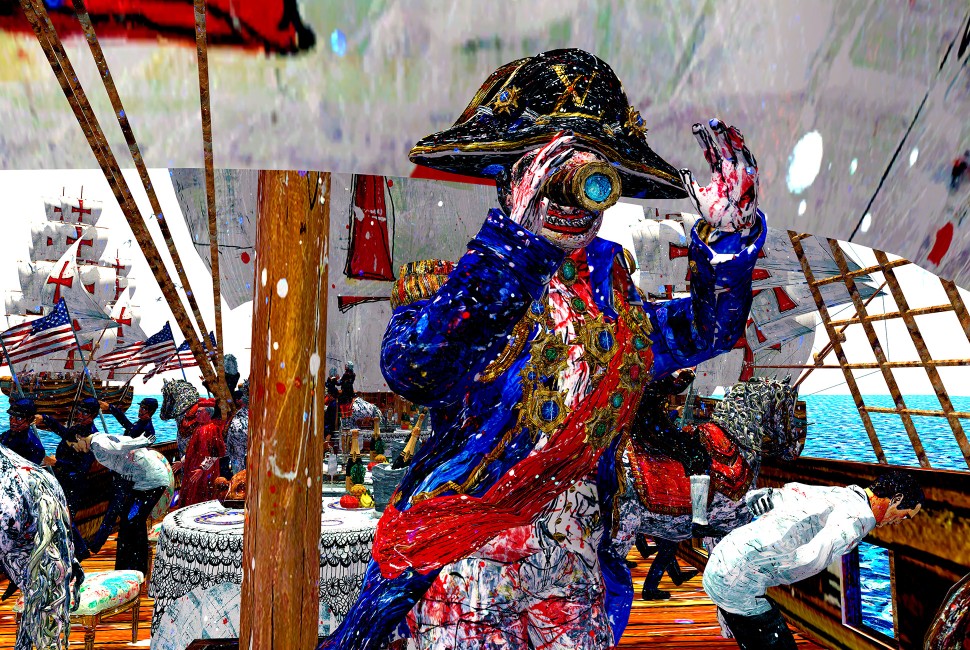Past and present, history and myth, reality and spectacle are conflated and distorted in Federico Solmi’s “The Great Farce” (2017), a monumental media work in the collection of Northwestern University’s Block Museum of Art, on view now through Dec. 1.
The exhibition is the first time The Block Museum has mounted the full presentation of Solmi’s installation “Federico Solmi: The Great Farce.” The immersive eight-minute installation consists of nine video projections spanning the entirety of The Block Museum's largest gallery.
The handmade and the high-tech are deftly blended in a large-scale and multiscreen presentation, that will project videos 10 feet tall and 42 feet wide on three walls. Solmi’s drawings and paintings serve as the foundation of a visual universe enlivened by a variety of technologies, including 3D animation, motion capture and video game software, to create a surreal take on American history.
> Related video: The Making of The Great Farce
“‘The Great Farce’ is one of Solmi’s most ambitious works in terms of technical complexity, physical scale and scope of content,” said exhibition curator Janet Dees, the Steven and Lisa Munster Tananbaum, Curator of Modern and Contemporary Art. “Throughout his practice, Solmi uses satire, farce and grotesque representations to question the complex relationships between nationalism, colonialism and consumerism. We hope ‘The Great Farce’ will open space for campus-wide discussion around many topics, including the use of satire as a form of social critique, and how popular culture can be a vehicle for reinforcing stereotypical and mythologized narratives of American history.”
An in-person keynote conversation with Solmi is planned for 6 p.m. on Wednesday, Oct. 23 at The Block Museum, 40 Arts Circle Drive in Evanston.
A frenzied American story
Featuring a cast of time-traveling world leaders with a feverish madness for power, Solmi’s animation turns a frenzied, fun-house mirror to grandstanding historical figures.
Solmi’s research for “The Great Farce” began with the question, “What is history?” The work specifically questions underlying premises that have shaped narratives about the founding of the U.S., ones that Solmi inherited growing up in Italy and which he encountered again when he emigrated to this country.
In Solmi’s surreal narrative, reality is an eternal amusement theme park.
“It has become a place where the world's leaders can rewrite, fabricate or travel to any event of the past, present or future,” Solmi writes in the project description. “They entertain, distract and misdirect the world's population through spectacle. Epic battles, great adventures and lavish ceremonies are staged as re-enactments of historic events...the resulting chaos dissolves any distinction between truth and myth, immortalizing the leaders, and elevating them as Gods to a faux Mount Olympus. From its heavenly terrace, they look out to admire their counterfeit universe.”
Solmi’s work often utilizes bright, brash colors and a satirical aesthetic to portray a dystopian vision of our present-day society. His exhibitions regularly feature a variety of media, including virtual reality experiences, video installations, painting, drawing and sculpture. Solmi uses his art as a vehicle to stimulate a robust conversation with his audience, highlighting the contradictions and fallibilities that characterize our time.
Solmi was born in 1973 in Bologna, Italy. Since 1999, he has lived and worked in New York. Most recently, his work was the subject of a major exhibition, “Federico Solmi: Ship of Fools,” at the Venice Biennale in 2024.
He was awarded the John Simon Guggenheim Memorial Fellowship in the category of Video & Audio by the Guggenheim Foundation of New York in 2019. His work was included in The Phillips Collection’s 100-year anniversary exhibition, “Seeing Differently,” the Smithsonian National Portrait Gallery’s traveling exhibition, “The Outwin 2019: American Portraiture Today,” as well as the inaugural exhibition of the Ocean Flower Museum Island in Hainan Province, Danzhou, China.



